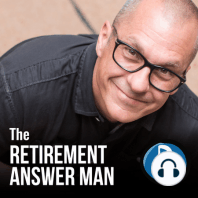30 min listen

Retirement Withdrawal Strategies: The Safety First Approach
Retirement Withdrawal Strategies: The Safety First Approach
ratings:
Length:
41 minutes
Released:
Jul 14, 2021
Format:
Podcast episode
Description
One of the biggest questions of retirement is how to withdraw your money. You can’t have a successful retirement without first planning how to withdraw your money. That is why we are discussing different retirement withdrawal strategies this month. Last week we covered the infamous 4% rule and today you’ll learn about the safety-first approach. In our next episode, you’ll hear about a hybrid approach and in the last episode of this series, you’ll discover how to build a framework for your own retirement withdrawal strategy. Are you ready to educate yourself on the various ways that you can withdraw your money in retirement? Press play to get started. What is the safety-first strategy? In the previous episode, you learned about a safe withdrawal strategy using the 4% rule. Whereas the 4% rule is a portfolio-based strategy, the safety-first strategy takes the opposite approach. Safety first ignores safe withdrawal rates and asset allocation. Instead, it focuses on creating income sources via various guaranteed income vehicles. The idea behind the safety-first approach is that retirement is too important to have variables like sequence of return risk that could ruin your retirement. How to implement the safety-first approach Since you only get one shot at retirement, the safety-first method secures a base income by using the assets you have. Prioritization is a key component to safety first. The first thing one must do to utilize the safety-first approach is to calculate your base needs over the span of your lifetime. Once you have this number, then you’ll subtract the income from your social capital so that you can see what’s left. With safety-first, you will secure your base needs by utilizing bond ladders or income annuities. After creating your income floor, then you can focus on building your contingency fund to help with life shocks. Once both of these bases are met then you can focus on any other retirement goals you may have. What are the advantages to safety-first? The first advantage that comes to mind with safety-first is peace of mind. By using the safety-first approach you won’t have to worry about the markets because you know that no matter what happens your base needs will be met. Another advantage is that this approach is easy to manage. There is not much to do after you have the plan in place but collect your monthly paycheck which makes this plan ideal for later in life. One more advantage is that since your needs are met you can focus on being more growth-oriented with the rest of your portfolio. The disadvantages of this approach The main disadvantage that I see with this approach is the lack of flexibility. If you have listened to the show before, you know that my methodology is all about staying agile. People change their minds a lot and life can completely change after retirement, so tying up your assets in an annuity can take away the power to change your mind. Another downfall to safety first is increased inflation risk. Most annuities do not adjust for inflation, so if there are any spikes in inflation you could be at risk. Listen in to discover if the safety-first approach is the right one for you. OUTLINE OF THIS EPISODE OF THE RETIREMENT ANSWER MAN PRACTICAL PLANNING SEGMENT [1:30] What is the safety-first strategy? [4:35] What are secure assets? [8:06] When to implement the safety-first strategy [10:20] Advantages and disadvantages to the safety-first strategy LISTENER QUESTIONS [17:55] How should I incorporate an inherited IRA into my retirement plan? [20:10] Taxes and Roth conversions [23:45] Does the 4% rule take into account social capital? [24:54] How do bonds work? [28:38] A pro-rata question TODAY’S SMART SPRINT SEGMENT [30:40] Do a basic calculation to figure how much of your base needs will be covered by guaranteed income sources THE FEEDBACK BOOTH [32:43] Women run the finances too [34:35] My 3rd attempt to discuss financial planning fees Resources Mentioned In This Episode
Released:
Jul 14, 2021
Format:
Podcast episode
Titles in the series (100)
Episode 2 The Importance of Tracking Your Net Worth: PLAN WELL INVEST WISELY by Retirement Answer Man